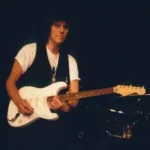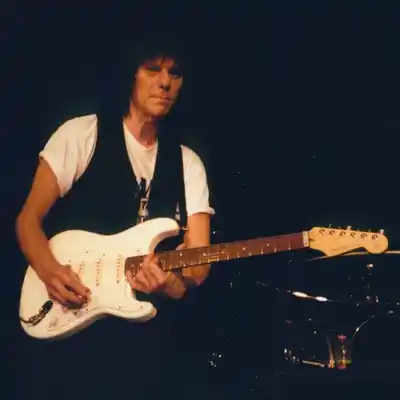
Jeff Beck – Iconic Guitars of The Legendary Guitarist
Jeff Beck was a true innovator in the world of rock and blues music. His career spanned more than five decades, during which he left an indelible mark on the guitar landscape with his jaw-dropping technique, unique tone, and experimental approach to music.
Let’s take a look back at his incredible life, the guitars he played, and the equipment he used to create his iconic sound.
Table of Contents
Biography
Born Geoffrey Arnold Beck on June 24, 1944, in Wallington, England, he first picked up the guitar at the age of 10 and was inspired by the likes of Les Paul and Cliff Gallup. He began his professional career in the early 1960s, playing in various bands, including The Nightshift and The Tridents. However, it was in 1965 when he replaced Eric Clapton in The Yardbirds that Beck’s career took off.
With The Yardbirds, Beck achieved his first commercial success and developed his signature style of guitar playing. He pushed the boundaries of what was possible on the instrument, experimenting with distortion, feedback, and unconventional techniques, like using a violin bow to play the guitar.
In 1967, Beck left The Yardbirds to form The Jeff Beck Group, where he continued to innovate and expand his musical horizons. The band released two critically acclaimed albums, “Truth” (1968) and “Beck-Ola” (1969), which featured a young Rod Stewart on vocals. After disbanding The Jeff Beck Group, he formed Beck, Bogert & Appice, releasing a self-titled album in 1973.
Throughout the ’70s, ’80s, and ’90s, Jeff Beck continued to push the boundaries of guitar playing, exploring various genres, including jazz fusion, instrumental rock, and electronica. He released numerous solo albums and collaborated with a wide array of artists, such as Stevie Wonder, Jan Hammer, and ZZ Top.
Jeff Beck’s influence on guitar playing and music as a whole is immeasurable. He was a member of the Rock and Roll Hall of Fame, both as a solo artist and as a member of The Yardbirds, and was awarded a total of eight Grammy Awards throughout his illustrious career.
Guitars
Jeff Beck was known for his love of Fender guitars, particularly the Fender Stratocaster and Fender Telecaster. He owned and played numerous vintage and custom models throughout his career, but there are a few that stand out.
- 1954 Fender Esquire: Beck’s first notable guitar was a white 1954 Fender Esquire, which he used during his time with The Yardbirds. This guitar was heavily modified, with a Gibson PAF humbucker added in the neck position.
- 1959 Fender Telecaster: Beck used a 1959 Fender Telecaster during his time with The Jeff Beck Group. This guitar, nicknamed “The Tele-Gib,” was heavily modified as well, with a Gibson PAF humbucker in the bridge position and a Stratocaster pickup in the neck position.
- 1960 Fender Stratocaster “Olympic White”: Beck’s most iconic guitar is undoubtedly his 1960 Olympic White Fender Stratocaster, which he used on several of his solo albums and live performances. This guitar featured a rosewood fingerboard, a large headstock, and a custom mirror pickguard.
- Jeff Beck Signature Stratocaster: In 1991, Fender introduced Jeff Beck Signature Stratocaster: In 1991, Fender introduced the Jeff Beck Signature Stratocaster, a guitar designed in collaboration with Beck himself. This model featured a unique neck shape, LSR roller nut, and noiseless pickups. Over the years, Fender has released multiple versions of this signature model, reflecting Beck’s evolving preferences and style.
- Fender Custom Shop Telecaster: In addition to his signature Stratocaster, Beck also played a Fender Custom Shop Telecaster, which he used on tracks such as “Nadia” from his 2001 album “You Had It Coming.” This Telecaster featured a gold sparkle finish and a unique middle pickup, adding to its distinctiveness.
Guitar Equipment
Jeff Beck was known for his minimalist approach to guitar equipment. He believed in letting his fingers do the talking, relying on his technique and expressiveness to create his iconic sound. However, some key pieces of gear contributed to his tone throughout the years.
- Amplifiers: Beck’s primary amplifiers were the Fender Twin Reverb and Fender Bassman, both of which he used extensively throughout his career. He also used Marshall amplifiers on occasion, particularly during his time with The Jeff Beck Group.
- Effects: Although he was not known for using a vast array of effects, Beck did employ a few key pedals. His most notable effect was the wah-wah pedal, which he used to great effect on tracks like “A Day in the Life” from his 2010 album “Emotion & Commotion.” He also utilized a delay pedal for slapback echo and an overdrive pedal for added sustain and drive.
- Guitar Picks and Slides: Jeff Beck was famous for his fingerstyle technique, which allowed him to create a wide range of tones and dynamics. However, he did use a pick on occasion, preferring heavy, thick picks for added control. Beck was also known to use a metal slide for added expression, particularly in his blues and slide guitar work.
On January 10, 2023, the world lost a legendary guitarist and extraordinary musician. From his early days with The Yardbirds to his groundbreaking solo work, Beck continually pushed the boundaries of what was possible on the guitar. His choice of guitars and equipment allowed him to express his unique voice and style, leaving an indelible mark on the world of music.
